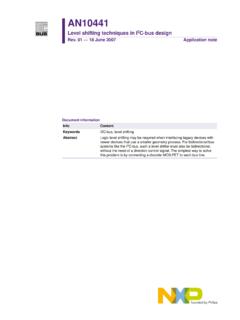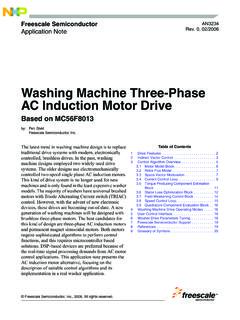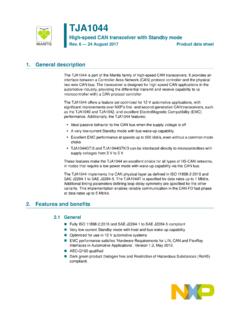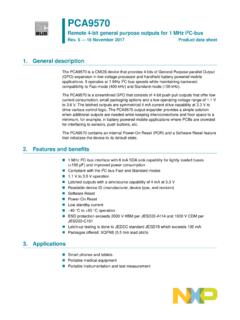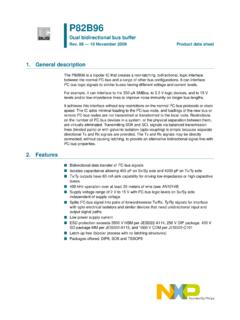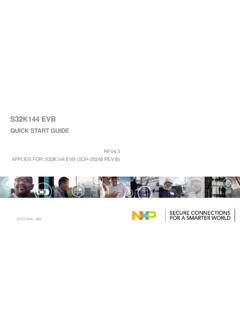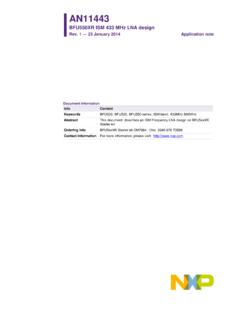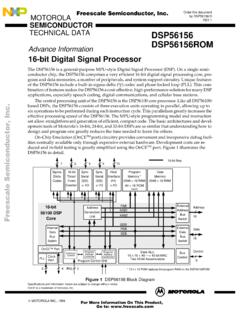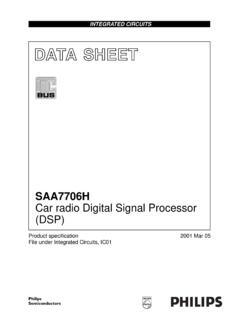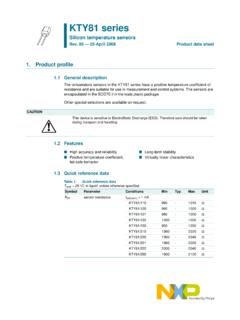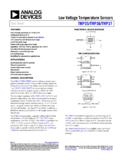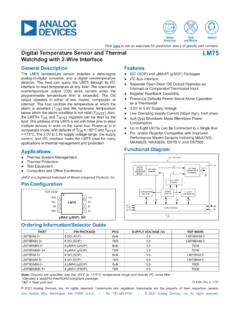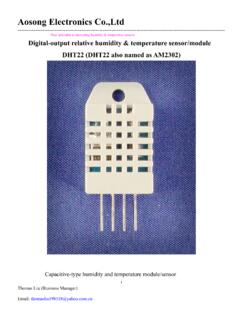Transcription of LM75B Digital temperature sensor and thermal watchdog
1 1. General descriptionThe LM75B is a temperature -to- Digital converter using an on-chip band gap temperature sensor and Sigma-Delta A-to-D conversion technique with an overtemperature detection output. The LM75B contains a number of data registers: Configuration register (Conf) to store the device settings such as device operation mode, OS operation mode, OS polarity and OS fault queue as described in Section 7 Functional description ; temperature register (Temp) to store the Digital temp reading, and set-point registers (Tos and Thyst) to store programmable overtemperature shutdown and hysteresis limits, that can be communicated by a controller via the 2-wire serial I2C-bus interface. The device also includes an open-drain output (OS) which becomes active when the temperature exceeds the programmed limits.
2 There are three selectable logic address pins so that eight devices can be connected on the same bus without address LM75B can be configured for different operation conditions. It can be set in normal mode to periodically monitor the ambient temperature , or in shutdown mode to minimize power consumption. The OS output operates in either of two selectable modes: OS comparator mode or OS interrupt mode. Its active state can be selected as either HIGH or LOW. The fault queue that defines the number of consecutive faults in order to activate the OS output is programmable as well as the set-point temperature register always stores an 11-bit two s complement data giving a temperature resolution of C. This high temperature resolution is particularly useful in applications of measuring precisely the thermal drift or runaway.
3 When the LM75B is accessed the conversion in process is not interrupted (that is, the I2C-bus section is totally independent of the Sigma-Delta converter section) and accessing the LM75B continuously without waiting at least one conversion time between communications will not prevent the device from updating the Temp register with a new conversion result. The new conversion result will be available immediately after the Temp register is LM75B powers up in the normal operation mode with the OS in comparator mode, temperature threshold of 80 C and hysteresis of 75 C, so that it can be used as a stand-alone thermostat with those pre-defined temperature set Features and benefits Pin-for-pin replacement for industry standard LM75 and LM75A and offers improved temperature resolution of C and specification of a single part over power supply range from V to V I2C-bus interface with up to 8 devices on the same bus Power supply range from V to V temperatures range from 55 C to +125 CLM75 BDigital temperature sensor and thermal watchdogRev.
4 6 February 2015 Product data sheetLM75 BAll information provided in this document is subject to legal disclaimers. NXP 2015. All rights data sheetRev. 6 February 2015 2 of 37 NXP SemiconductorsLM75 BDigital temperature sensor and thermal watchdog Frequency range 20 Hz to 400 kHz with bus fault time-out to prevent hanging up the bus 11-bit ADC that offers a temperature resolution of C temperature accuracy of: 2 C from 25 C to +100 C 3 C from 55 C to +125 C Programmable temperature threshold and hysteresis set points Supply current of A in shutdown mode for power conservation Stand-alone operation as thermostat at power-up ESD protection exceeds 4500 V HBM per JESD22-A114 and 1000 V CDM per JESD22-C101 Latch-up testing is done to JEDEC Standard JESD78 which exceeds 100 mA Small 8-pin package types: SO8, TSSOP8, 3 mm 2 mm XSON8U, and 2mm 3mmHWSON83.
5 Applications System thermal management Personal computers Electronics equipment Industrial controllersLM75 BAll information provided in this document is subject to legal disclaimers. NXP 2015. All rights data sheetRev. 6 February 2015 3 of 37 NXP SemiconductorsLM75 BDigital temperature sensor and thermal watchdog4. Ordering information [1]LM75 BGD cannot be production cold temperature tested because of manufacturing process constraints. Although no LM75 BGD complaints have been noted, NXP recommends consideration/use of the LM75 BTP instead of the LM75 BGD in operating environments of less than 0 Ordering options Table informationType numberTopside markPackageNameDescriptionVersionLM75 BDLM75 BDSO8plastic small outline package; 8 leads; body width mmSOT96-1LM75 BDPLM75 BTSSOP8plastic thin shrink small outline package; 8 leads; body width 3 mmSOT505-1LM75 BGD[1]75 BXSON8U plastic extremely thin small outline package; no leads; 8 terminals; UTLP based; body 3 2 mmSOT996-2LM75 BTPM75 HWSON8 plastic thermal enhanced very very thin small outline package; no leads.
6 8 terminals, 2 3 mmSOT1069-2 Table optionsType numberOrderable part numberPackagePacking methodMinimum order quantityTemperatureLM75 BDLM75BD,112SO8 Standard marking * IC s tube -DSC bulk pack2000 Tamb= 55 C to +125 CLM75BD,118SO8 Reel 13 Q1/T1 *Standard mark SMD2500 Tamb= 55 C to +125 CLM75 BDPLM75 BDP,118 TSSOP8 Reel 13 Q1/T1 *Standard mark SMD2500 Tamb= 55 C to +125 CLM75 BGDLM75 BGD,125 XSON8 UReel 7 Q3/T4 *Standard mark3000 Tamb= 55 C to +125 CLM75 BTPLM75 BTP,147 HWSON8 Reel 7 Q2/T3 *Standard mark4000 Tamb= 55 C to +125 CLM75 BAll information provided in this document is subject to legal disclaimers. NXP 2015. All rights data sheetRev. 6 February 2015 4 of 37 NXP SemiconductorsLM75 BDigital temperature sensor and thermal watchdog5. Block diagram 6.
7 Pinning Pinning Fig diagram of LM75 BLM75 BSDAVCCSCLA0 OSA1 GNDA2002aad453 BIASREFERENCEBAND GAPTEMP SENSOROSCILLATORPOWER-ONRESET11-BITSIGMA -DELTAA-to-DCONVERTERPOINTERREGISTERTIME RCOMPARATOR/INTERRUPTCOUNTERLOGIC CONTROL AND INTERFACECONFIGURATIONREGISTERTHYSTREGIS TERTOSREGISTERTEMPERATUREREGISTERFig configuration for SO8 Fig configuration for TSSOP8 Fig configuration for XSON8 UFig configuration for HWSON8LM75 BDSDAVCCSCLA0 OSA1 GNDA2002aad45412346587LM75 BDPSDAVCCSCLA0 OSA1 GNDA2002aad45512346587002aae234LM75 BGDT ransparent top view87651234 SDASCLOSGNDVCCA0A1A2002aag155terminal 1index area1 SDALM75 BTPT ransparent top view2 SCL3OS48765 GNDVCCA0A1A2LM75 BAll information provided in this document is subject to legal disclaimers. NXP 2015. All rights data sheetRev.
8 6 February 2015 5 of 37 NXP SemiconductorsLM75 BDigital temperature sensor and thermal Pin description 7. Functional General operationThe LM75B uses the on-chip band gap sensor to measure the device temperature with the resolution of C and stores the 11-bit two s complement Digital data , resulted from 11-bit A-to-D conversion, into the device Temp register. This Temp register can be read at any time by a controller on the I2C-bus. Reading temperature data does not affect the conversion in progress during the read device can be set to operate in either mode: normal or shutdown. In normal operation mode, the temp-to- Digital conversion is executed every 100 ms and the Temp register is updated at the end of each conversion. During each conversion period (Tconv) of about 100 ms the device takes only about 10 ms, called temperature conversion time (tconv(T)), to complete a temperature -to- data conversion and then becomes idle for the time remaining in the period.
9 This feature is implemented to significantly reduce the device power dissipation. In shutdown mode, the device becomes idle, data conversion is disabled and the Temp register holds the latest result; however, the device I2C-bus interface is still active and register write/read operation can be performed. The device operation mode is controllable by programming bit B0 of the configuration register. The temperature conversion is initiated when the device is powered-up or put back into normal mode from addition, at the end of each conversion in normal mode, the temperature data (or Temp) in the Temp register is automatically compared with the overtemperature shutdown threshold data (or Tth(ots)) stored in the Tos register, and the hysteresis data (or Thys) stored in the Thyst register, in order to set the state of the device OS output accordingly.
10 The device Tos and Thyst registers are write/read capable, and both operate with 9-bit two s complement Digital data . To match with this 9-bit operation, the Temp register uses only the 9 MSB bits of its 11-bit data for the way that the OS output responds to the comparison operation depends upon the OS operation mode selected by configuration bit B1, and the user-defined fault queue defined by configuration bits B3 and descriptionSymbolPinDescriptionSDA1 Digital I/O. I2C-bus serial bidirectional data line; input. I2C-bus serial clock Shutdown output; To be connected to the system input. User-defined address bit input. User-defined address bit input. User-defined address bit information provided in this document is subject to legal disclaimers. NXP 2015.

